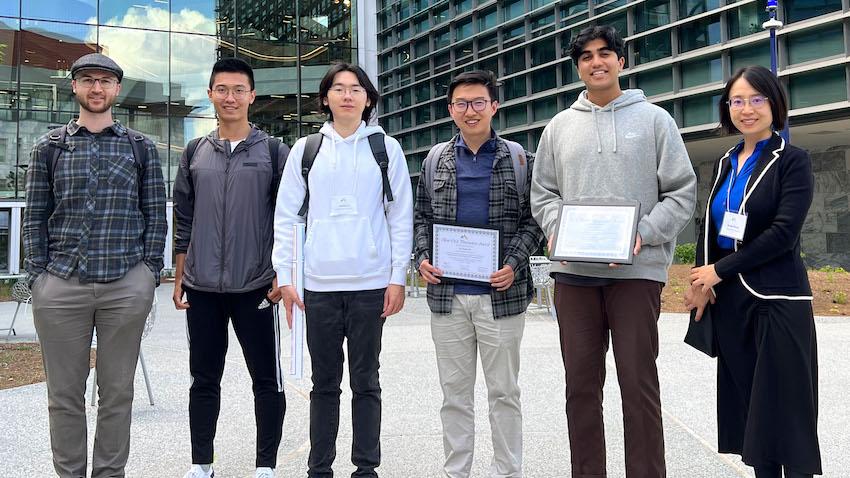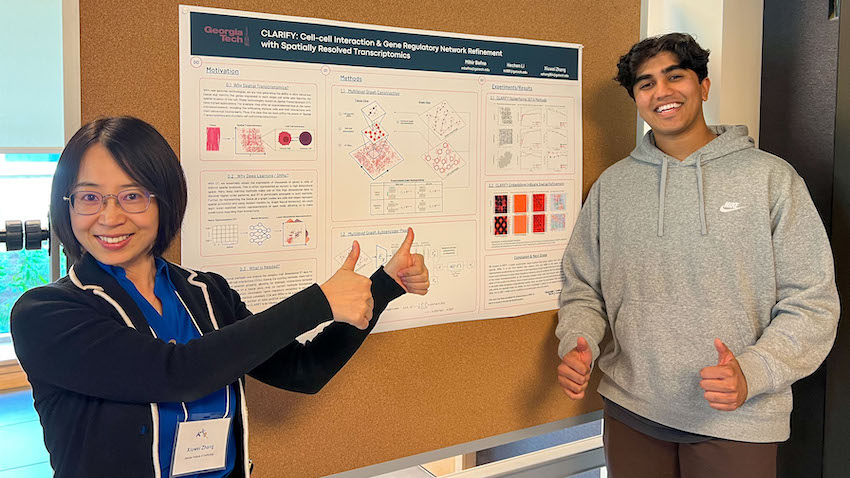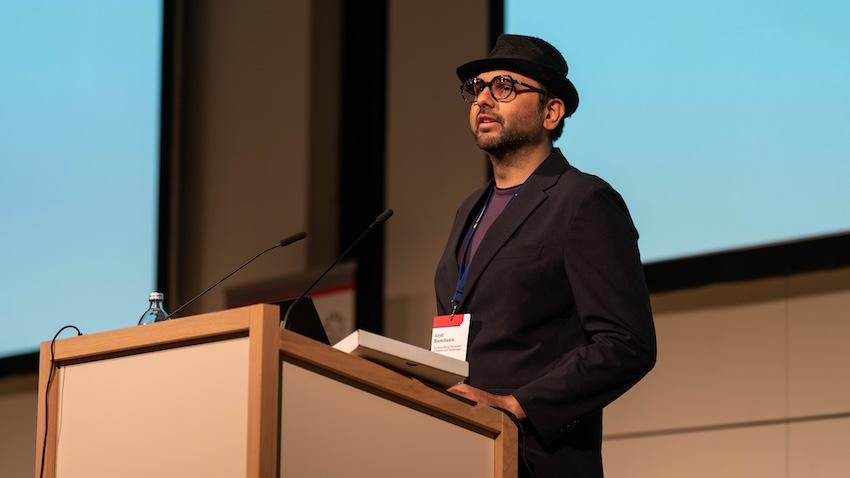
Award-winning Computer Models Propel Research in Cellular Differentiation
The discovery of nucleic acids is a recent event in the history of scientific phenomena and there is still much to learn from the enigma that is genetic code.
Advances in computing techniques are ushering in a new age of understanding the macromolecules that form life as we know it. One Georgia Tech research group is now receiving well-deserved accolades for their applications in data science and machine learning toward single-cell omics research.
Students studying under Xiuwei Zhang, an assistant professor in the School of Computational Science and Engineering (CSE), received awards in April at the Atlanta Workshop on Single-cell Omics (AWSOM 2023).
School of CSE Ph.D. student Ziqi Zhang received the best oral presentation award, while Mihir Birfna, an undergraduate student majoring in computer science, took the best poster prize.
Along with providing computational tools for biological researchers, the group’s papers presented at AWSOM 2023 could benefit populations as the research could lead to improved disease detection and prevention. They can also provide a better understanding of the causes and treatments of cancer and a new ability to accurately simulate cellular processes.
“I am extremely proud of the entire research group and very thankful for their work and our teamwork within our lab,” said Xiuwei Zhang. “These awards are encouraging because it means we are on the right track of developing something that will contribute both to the biology community and the computational community.”
Ziqi Zhang presented the group’s findings of their deep learning framework called scDisInFact, which can carry out multiple key single-cell RNA-sequencing (scRNA-seq) tasks all at once and outperform current models that focus on the same tasks individually.
The group successfully tested scDisInFact on simulated and real Covid-19 datasets, demonstrating applicability in future studies of other diseases.
Bafna’s poster introduced CLARIFY, a tool that connects biochemical signals occurring within a cell and intercellular communication molecules. Previously, the inter- and intra-cell signaling were often studied separately due to the complexity of each problem.
Oncology is one field that stands to benefit from CLARIFY. CLARIFY helps to understand the interactions between tumor cells and immune cells in cancer microenvironments, which is crucial for enabling the success of cancer immunotherapy.

At AWSOM 2023, the group presented a third paper on scMultiSim. This simulator generates data found in multi-modal single-cell experiments by modeling various biological factors underlying the generated data. It enables quantitative evaluations of a wide range of computational methods in single-cell genomics. That has been a challenging problem due to the lack of ground truth information in biology, Xiuwei Zhang said.
“We want to answer certain basic questions in biology, like how we get these different cell types like skin cells, bone cells, and blood cells,” she said. “If we understand how things work in normal and healthy cells, and compare that to the data of diseased cells, then we can find the key differences between those two and locate the genes, proteins, and other molecules that cause problems.”
Xiuwei Zhang’s group specializes in machine learning and optimization skills used to analyze single-cell omics data and scRNA-seq methods. Their main interest is studying mechanisms of cellular differentiation— the process when young, immature cells mature and take on functional characteristics.
scRNA-seq is an approach to research in molecular biology that is growing in popularity. It gives insight into the existence and behavior of different types of cells. This helps researchers understand genetic disorders, detect mechanisms that cause tumors and cancer, and develop new treatments, cures, and drugs.
If microenvironments filled with various macromolecules and genetic material are considered datasets, the need for researchers like Xiuwei Zhang and her group is obvious. These massive, complex datasets present challenges and opportunities for the group experienced in computational and biological research.
Collaborating authors include School of CSE Ph.D. students Hechen Li and Michael Squires, School of Electrical and Computer Engineering Ph.D. student Xinye Zhao, Wallace H. Coulter Department of Biomedical Engineering Associate Professor Peng Qiu, and Xi Chen, an assistant professor at Southern University of Science and Technology in Shenzhen, China.
The group’s presentations at AWSOM 2023 exhibited how their work makes progress in biomedical research, as well as advancing scientific computing methods in data science, machine learning, and simulation.
scDisInFact is an optimization tool that can perform batch effect removal, condition-associated key gene detection, and perturbation, which is made possible by considering major variation factors in the data. Without considering all these factors, current models can only do these tasks individually. But scDisInFact can do each of these tasks better, and all at the same time.
CLARIFY delves into how cells employ genetic material to communicate internally, using gene regulatory networks (GRNs) and externally, called cell-cell interactions (CCIs). Many computational methods can infer GRNs, and inference methods have been proposed for CCIs. But until CLARIFY, a way to infer GRNs and CCIs in the same model did not exist.
scMultiSim simulations perform closer to real-world conditions than current simulators that model only one or two biological factors. This helps researchers to realistically test their computational methods, which can guide directions for future method development.
Whether they be computer scientists, biologists, or non-academics alike, the advantage of interdisciplinary and collaborative research, like Xiuwei Zhang’s group, is its wide-reaching impact that advances technology to improve the human condition.
“We’re exploring the possibilities that can be realized by advanced computational methods combined with cutting-edge biotechnology,” said Xiuwei Zhang. “Since biotechnology keeps evolving very fast and we want to help push this further by developing computational methods, together we will propel science forward.”


